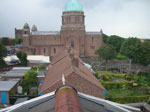"Montebello"
St. Georges Mount
New Brighton,
Cheshire, England
The Architects of Montebello were Messrs Teite (?spelling) of Liverpool.
Montebello was the home of my Great Great Grandparents, Charles William Harrison Pickering and his wife Elizabeth Walker. Most of their 11 children traveled to all corners of the world as they left Montebello to strike out on their own. My Great Grandfather, Alexander John was born in this home before eventually emigrated to the United States. This photograph [right] has been in my family for several generations. When I "found" another branch of our family just recently I sent them a copy of this photo - and lo! and behold - they also had a copy!
I decided it would be fun to learn more about this home since the family obviously were well enough off to support this seemingly huge house and, according to the 1881 Census, a considerable number of servants.
David Eckersley-Maslin of the U.K., a descendant of Edith Paulina Pickering Myers, sent the site map and description of the properties our ancestors lived.
To find out what happened to our ancestrial home, read the letters from folks who lived nearby in the letters and correspondences on this page.
History of Montebello, St. Georges Mount, Wallasey, Cheshire
1860-1881 - CWHPickering built & lived - Single Family Home
1882-1895 - Pickering, Mrs. E.P. (widow)
1897 - Karran, John E., Liverpool Ship Owner
1910 - Fran Joseph Thoma, Austrian
1911 - Isabella Robinson, Widow, was Private Hotel Keeper and head of Montebello. Montebello held 13 "visitors" (notably the family of Moritz Zinn, Hemp Merchant of Russia) and 1 Servant.
During WWII it was converted to a convalescent home for sailors.
1944 - Coach house and stables sold to a Mr. Wood.
About 1976 Montebello was torn down to make room for more modern buildings.
St. George's Mount, Site Plan of 1899
"This house, which stood at the north corner of St. George's Mount and Atherton Street, was built about 1860 for a Liverpool merchant, Mr. Charles William Harrison Pickering. Prior to moving here, Mr. Pickering lived first at "Withenfield House", Withen Lane, and later at "Springfield House", the site of which is now occupied roughly by Vicarage Grove. In those days the new house must have commanded unsurpassed views out to sea, and it is not surprising that Mr. Pickering named the property "Monte Bello". The grounds ran down to St. Jame's Road, where there was a lodge, while the stables, still standing and used residentially, were situated opposite on the south side of St. George's Mount.
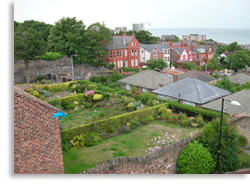
View from St. Georges Mount, 2009.
Photo courtesy of G. Dawson
Mr. Pickering, after whom Pickering Road was presumably named, died in 1881 at the age of 65 and was buried in St. Hilary's Churchyard, although he worshipped at St. James's Church, where there is, or was, a stained glass window to his memory. His widow continued to live at "Monte Bello" until her own death in 1895, and the following year the Trustees of her late husband's Will sold the whole of the property, consisting of the house, the stables and over 6,000 sq. yds. of land to a Liverpool Shipowner, Mr. John Karran, for £3,010. Four years later he, too, died, but his widow remained in residence for some years, finally dying at Douglas, Isle of Man, in 1907. Round about 1910, the house was leased from the Karran Trustees by Mrs. Isobel Robinson, who converted it inot a private hotel, still known as "Monte Bello", and as such it continued until World War II.
In 1944 the Trustees sold off the coach-house and stables separately to a Mr. Wood, who died in 1979 and the following year disposed of the remainder of the property to an Estate Company for £3,500. Ten years later it was acquired by Thomas & Caley Ltd., a local building company, the house having been demolished in the meantime, and they developed the area with the attractive smaller residences which are to be seen there today."
Source: History of Wallasey website, "Mansions of Wallasey", St George's Mount.
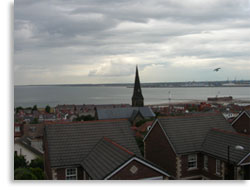
View from St. Georges Mount, 2009.
Photo courtesy of G. Dawson
NOTES: According to an interview on Jan. 24 1979 of a descendant of Henry Alfred: "CWHP lived in Springfield Estate, now Vicarrage Grove while Montebello was being built. On the corner of Rice Lane and Spring Lane was Vicarrage for St. John's Church, and by 1840 was called Locust House."
David Eckersley-Maslin confirmed this information in Aug 2001 with the above article and add the following descriptions of other residences of the Pickering family.
SPRINGFIELD HOUSE. At the corner of Rice Lane and Green Lane (later Greenwood Lane) was a house called SPRINGFIELD, with a garden running down to the top of Trafalgar Road. For some years the house was used as the vicarage of St. John's Church, hence the street called Vicarage Grove on its site. It was built about 1829-30 by Mr. William Maury an East-Indian mercant, and originally called The Locusts. Up to 1840 it appears on maps as Locust House and after that at SPRINGFIELD. At one time it was the residence of the Rev. W.E.B. Gunn.
WITHENSFIELD HOUSE. Until Seabank Road was cut through the fileds, King Street (formally Barn Lane but now called after Ellen King, who owned the land) ended at Green Lane (now Greenwood Lane) and the first houses in Seabank Road, one of which was pulled down to widen the corner, had only fields in front. King Street was at first purely residential; with the exception of a few shops in Tobin Street the nearest shops were in Seacombe. Manor Lane was another of the private roads of the Parish guarded with large stone pillars, and it is believed at one time also gates, at the junction with Withens Lane. Withens Lane was probably given its name because it led into a field called The Withens. There is now a cul-de-sac off it called Withensfield, on the site of the old WITHENSFIELD HOUSE which for many years was a school.
The home was at one time used as a sort of boarding school for young ladies in 1870. At a later date, the house was used as a Y.W.C.A., whre young ladies could spend a holiday. For 28 shgillings a week they were provided with a room and meals. In the twenties, the Christian Alliance for Women and Girls took over as a hostel where young women could find good lodgings.
ST. JOHN'S CHURCH & SPRINGFIELD HOUSE. The first vicar of St. John's Church was Sir John Tobin's son, the Rev. John Tobin, M.A. who lived in Liscard House, where Chasworth Avenue is now. There used to be an old house called SPRINGFIELDS at the corner of Rice Lane, where it meets Greenwood Lane (formally Green Lane). This was used as the Vicarage Grove is on the site. The Rev. W.E.B. Gunn was vicar at the time. The famous "Woodbine Willie" preached at St. John's after the First World War and caused much interest amongst the parisioners who discussed his powerful sermons. In 1932 came the Rev. Colin Roger Montgomery as vicar. His brother was the famouns World War Two Field Marshal.
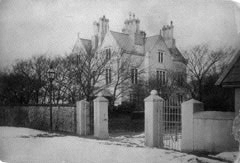
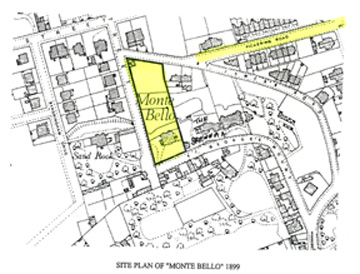
The photos below were found in a scrapbook that was found and purchased at a "yard sale" in England. The purchaser contacted me and sent these wonderful images of Montebello, the views in the 1800's, and family members.
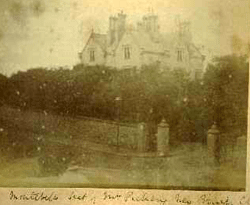
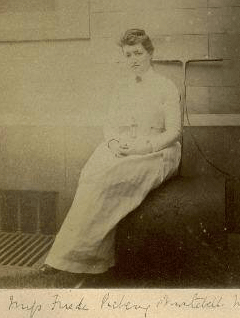
Frieda Pickering at Montebello
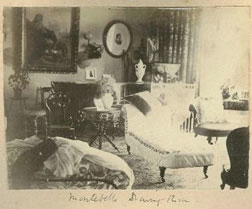
Drawing Room at Montebello
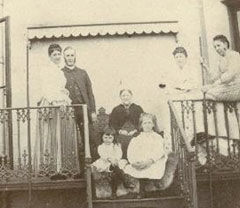
Group of family members on the verandah
Letter from Alex, Yorktown, Virginia
" I have just read with great interest, the article about the Montebello.
My memories of the Monty, go back to about 1940, This was a wonderful building that was located only about 2 or 3 minutes from my home, it was built at the top of Atherton Street and on the corner of Saint George's Mount. As I have mentioned I remember the place vividly from the early 40's. I myself was born in 1937, so I guess that the start of my recollection would be in those early years of the second world war.
If my memory serves me correctly the Monty was occupied by United States troops, during those war years, as were a great many large homes in that area, but when the war was over it became abandoned, and for the likes of us young children it was indeed a great source of adventure, In fact a long lost childhood friend of mine made contact with me 2 years ago, from Tasmania and the first comment was to remind me of the Montebello.
The Montebello as I have said was located at the top of Atherton Street overlooking the River Mersey as it opened out into the Irish Sea. It was a very large home with gardens that were on three different levels, due to the steepness of Atherton Street. I wish that I could think of the acreage that the property covered, to us small kids it was wonderful, and seemed to be so large, but what I had thought was large back then seems so small since I moved here to the States in 1968.
The picture that you have is of the side of the property on St George's Mount, the other side was as I mentioned on Atherton street. The Atherton Side had high sandstone walls , and the bottom of the property backed on to some homes on St James Road, off of which was and still is Pickering Road. If you would like a map of the area I will gladly scan from a mapbook that I have. Funny thing is that as I am writing this letter my left elbow is starting to ache and I am writing with my right hand, I guess it is because, when I was about 8 or 9 years old we were playing around and I was climbing over one of the gates at the Monty when I fell and broke my left arm, I had to go in hospital and missed my vacation to Wales.
Yes indeed the Montebello has some great memories for me. It was knocked down in the early 50's and homes were built on all three of the levels of the original property. I hope that some of this gibberish helps you in your search of the past."
Cheers, Alex
